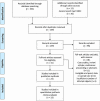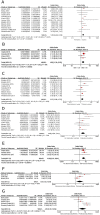Risk factors for postoperative surgical site infections after anterior cruciate ligament reconstruction: a systematic review and meta-analysis
- PMID: 36517215
- PMCID: PMC9872252
- DOI: 10.1136/bjsports-2022-105448
Risk factors for postoperative surgical site infections after anterior cruciate ligament reconstruction: a systematic review and meta-analysis
Abstract
Objectives: The primary aim was to evaluate risk factors for surgical site infections after anterior cruciate ligament reconstruction (ACLR). The secondary aim was to investigate the surgical site infection incidence rate and the mean time to postoperative surgical site infection symptoms.
Design: Systematic review and meta-analysis.
Data sources: PubMed, Embase and Web of Science were searched from database inception to September 2021 and updated in April 2022.
Eligibility criteria: Quantitative, original studies reporting potential risk factors for surgical site infections after ACLR were included.
Results: Twenty-three studies with 3871 infection events from 469 441 ACLRs met the inclusion criteria. Male sex (OR 1.78, p< 0.00001), obesity (OR 1.82, p=0.0005), tobacco use (OR 1.37, p=0.01), diabetes mellitus (OR 3.40, p=0.002), steroid use history (OR 4.80, p<0.00001), previous knee surgery history (OR 3.63, p=0.02), professional athlete (OR 4.56, p=0.02), revision surgery (OR 2.05, p=0.04), hamstring autografts (OR 2.83, p<0.00001), concomitant lateral extra-articular tenodesis (OR 3.92, p=0.0001) and a long operating time (weighted mean difference 8.12, p=0.005) were identified as factors that increased the risk of surgical site infections (superficial and deep) after ACLR. Age, outpatient or inpatient surgery, bone-patellar tendon-bone autografts or allografts and a concomitant meniscus suture did not increase the risk of surgical site infections. The incidence of surgical site infections after ACLR was approximately 1% (95% CI 0.7% to 1.2%). The mean time from surgery to the onset of surgical site infection symptoms was approximately 17.1 days (95% CI 13.2 to 21.0 days).
Conclusion: Male sex, obesity, tobacco use, diabetes mellitus, steroid use history, previous knee surgery history, professional athletes, revision surgery, hamstring autografts, concomitant lateral extra-articular tenodesis and a long operation time may increase the risk of surgical site infections after ACLR. Although the risk of surgical site infections after ACLR is low, raising awareness and implementing effective preventions for risk factors are priorities for clinicians to reduce the incidence of surgical site infections due to its seriousness.
Keywords: infection; knee; ligaments; meta-analysis; risk factor.
© Author(s) (or their employer(s)) 2023. Re-use permitted under CC BY-NC. No commercial re-use. See rights and permissions. Published by BMJ.
Conflict of interest statement
Competing interests: None declared.
Figures




References
-
- The Swedish knee ligament register annual report, 2020. Available: https://aclregister.nu/media/uploads/Annual%20reports/rapport2020en.pdf
Publication types
MeSH terms
Substances
LinkOut - more resources
Full Text Sources
Medical
Miscellaneous
